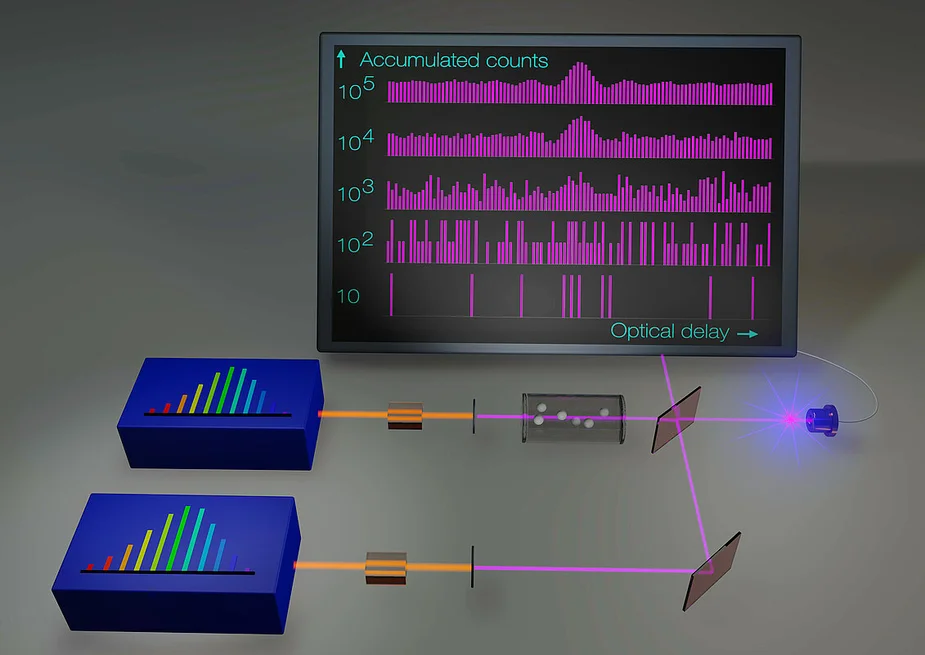Optical Frequency Combs Make Ultraviolet Spectroscopy More Sensitive and More Precise
New technique enables experiments in the ultraviolet spectral region at very feeble light levels
In a recent publication in Nature, researchers at the Max Born Institute (MBI) in Berlin, Germany, and at Max-Planck Institute of Quantum Optics in Garching report on a new technique for deciphering the properties of matter with light, that can simultaneously detect and precisely quantify many substances with a high chemical selectivity. Their technique interrogates the atoms and molecules in the ultraviolet spectral region at very feeble light levels. Using two optical frequency combs and a photon counter, the experiments open up exciting prospects for conducting dual-comb spectroscopy in low-light conditions and they pave the way for novel applications of photon-level diagnostics, such as precision spectroscopy of single atoms or molecules for fundamental tests of physics and ultraviolet photochemistry in the Earth’s atmosphere or from space telescopes.
Ultraviolet spectroscopy plays a critical role in the study of electronic transitions in atoms and rovibronic transitions in molecules. These studies are essential for tests of fundamental physics, quantum-electrodynamics theory, determination of fundamental constants, precision measurements, optical clocks, high-resolution spectroscopy in support of atmospheric chemistry and astrophysics, and strong-field physics. Scientists in the group of Nathalie Picqué have now made a significant leap in the field of ultraviolet spectroscopy by successfully implementing high-resolution linear-absorption dual-comb spectroscopy in the ultraviolet spectral range. This groundbreaking achievement opens up new possibilities for performing experiments under low-light conditions, paving the way for novel applications in various scientific and technological fields.
Dual-comb spectroscopy, a powerful technique for precise spectroscopy over broad spectral bandwidths, has been mainly used for infrared linear absorption of small molecules in the gas phase. It relies on measuring the time-dependent interference between two frequency combs with slightly different repetition frequencies. A frequency comb is a spectrum of evenly spaced, phase-coherent laser lines, that acts like a ruler to measure the frequency of light with extreme precision. The dual-comb technique does not suffer from the geometric limitations associated with traditional spectrometers, and offers great potential for high precision and accuracy.
However, dual-comb spectroscopy typically requires intense laser beams, making it less suitable for scenarios where low light levels are critical. The team have now experimentally demonstrated that dual-comb spectroscopy can be effectively employed in starved-light conditions, at power levels more than a million times weaker than those typically used. This breakthrough was achieved using two distinct experimental setups with different types of frequency-comb generators. The team developed a photon-level interferometer (Fig.1) that accurately records the statistics of photon counting, showcasing a signal-to-noise ratio at the fundamental limit. This achievement highlights the optimal use of available light for experiments, and opens up the prospect of dual-comb spectroscopy in challenging scenarios where low light levels are essential.
Publication
Near-ultraviolet photon-counting dual-comb spectroscopy
Bingxin Xu, Zaijun Chen, Theordor W. Hänsch, Nathalie Picqué
Nature 627, 289-294 (2024), https://doi.org/10.1038/s41586-024-07094-9
Contact:
Max Born Institute for Nonlinear Optics and Short Pulse Spectroscopy
Prof. Dr. Nathalie Picqué
Director
030 6392-1400
Nathalie.Picque(at)mbi-berlin.de
mbi-berlin.de
Press release MBI, 13 March 2024
